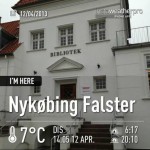Smartphones and mobile devices have a global positioning system (GPS) built into them. This allows your mobile device to locate your position on a map. This also allows library clients and staff to locate themselves on a map and to get directions to different locations. You can see this at work in “real time” tracking apps for bus and train timetables.
DISCOVER:
- Try out the maps installed on your device. You can also download map apps, try the Google Map app for example.
- Try out the directions functions for different options (walk, drive, public transport). What are the directions to your library like?
- Google Maps also have indoor maps which include many cultural institutions including libraries
EXPLORE:
- Foursquare is a social media tool that uses GPS to check into locations, there are badges to be earned and the status of Mayor if you check in more times than anyone else (see the Bookworm badge and instructions ) NB: a number of other apps interact with Foursquare
- LibraryThing has a free app called Readar (it was formerly Local Books), with more than 80,500 bookstores, libraries and bookish events listed it uses GPS to allow the user to locate nearby venues and literary events
- Facebook also has a check in option
- There are more useful links on our Pinterest Board
THINKING POINTS:
- Do you use maps as wayfinding guides inside your library (eg. University of Virginia Library )
- If your library facility is large or spread over several locations does your website or app include maps?
- Have you considered geocaching as a library program / allowing interaction with the library as a destination (eg. British Library )
- Could you use geocaching as an educational and outreach tool (eg. Andrew Spencer describes how it was used at Macquarie University Library)
- Have you considered editing the information about your library in Librarything Readar, Google places and Foursquare, perhaps adding some photos?
- Do you have any signs in your library to encourage people to “check in”?
- Have you considered holding a competition with Foursquare check ins at your library?

